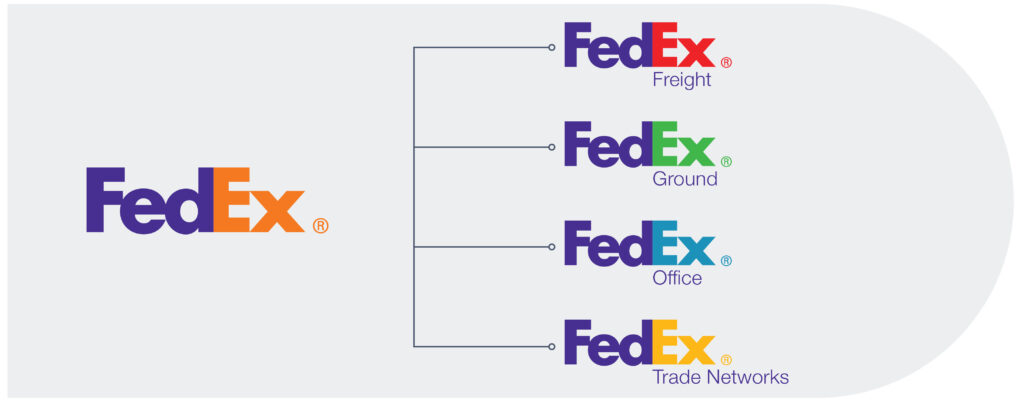Is your brand structure in disarray? Has rapid growth left you with a fragmented brand architecture? Are your prospects confused about your brand’s identity? You’re not alone—brand architecture issues are common for companies that have expanded quickly or repositioned multiple times.
A strong and cohesive brand architecture is essential in today’s competitive business landscape. As companies grow and evolve, they need to reassess their brand structure to stay aligned with their goals and market demands. Sagefrog’s expertise in brand architecture ensures your brand remains strategic and impactful. Our newest infographic outlines four crucial steps to building a robust brand architecture: pinpointing your situation, defining your goals, assessing brand equity, and selecting the right brand architecture type.
This blog provides deeper insights into each step and offers practical advice for navigating brand complexities. Whether you’re facing a merger, expanding product lines, or rebranding, understanding these steps will help you make informed, strategic decisions.
Step 1: Pinpoint Your Situation
Understanding why you need to evaluate your brand architecture is crucial for making informed decisions. Here, we delve into critical scenarios where reassessing your brand architecture becomes essential.
- Merger & Acquisition
Mergers and acquisitions present unique challenges and opportunities for brand architecture. When two companies merge, they often combine distinct brand identities, cultures, and market perceptions. It’s vital to evaluate how these brands can coexist or whether a unified brand strategy would serve better. The primary goals during M&A are to maximize brand equity, minimize customer confusion, and leverage the strengths of both brands to create a competitive edge. - Market Repositioning
As markets evolve, companies may need to reposition their brands to stay relevant. This might involve shifting from a niche market to a broader audience or changing the brand’s image to reflect new values or innovations. Reassessing brand architecture during market repositioning ensures that all sub-brands align with the new market strategy and contribute to a cohesive brand image.
- Brand Consolidation
Over time, companies may accumulate multiple sub-brands, leading to brand dilution and inefficiencies. Brand consolidation involves streamlining these sub-brands to strengthen the parent brand, reduce costs, and enhance market presence. This process requires carefully assessing each sub-brand’s value and strategic fit within the brand portfolio.
- Expanding Product Lines
Introducing new products can complicate existing brand architecture. Ensuring new products fit seamlessly into the current brand structure helps maintain brand clarity and equity. This might involve creating new sub-brands or integrating products under existing ones.
- Rebranding Efforts
Rebranding is a comprehensive process that often necessitates a fresh look at brand architecture. Whether due to outdated branding, a shift in company vision, or a response to market changes, rebranding ensures that all brand elements are aligned with the new direction.
- Global Expansion
Entering new international markets requires a brand architecture that accommodates diverse cultural, linguistic, and market needs. A flexible brand architecture can help maintain a consistent global brand image while allowing for regional adaptations.
Step 2: Dive Into Your Goals
Clear goals and considerations are fundamental to developing a compelling brand architecture. Here are some critical aspects to consider:
- Prominence of Parent/Master Brand: Decide the visibility and dominance of the parent brand over sub-brands. This impacts customer perception and brand equity.
- Number of Sub-brands, Products, and Services: Assess the current portfolio to understand the complexity and potential overlaps.
- Similarity or Difference Among Sub-brands: Evaluate how closely related or distinct your sub-brands are to determine the best architectural approach.
- Support or Competition Among Sub-brands: Analyze whether sub-brands complement or compete with each other, affecting market strategy and customer choice.
- Cost vs. Revenue of Sub-brands: Measure each sub-brand’s financial performance to identify optimization opportunities.
- Emerging Market Trends or Competitive Situations: Stay informed about market dynamics to ensure your brand architecture remains relevant and competitive.
Step 3: Assess Your Brand Equity
Measuring brand equity is essential to understand the value and impact of your brands in the marketplace. Sagefrog recommends assessing brand strength through various metrics:
- Customer Purchase Intent: Indicates the likelihood of customers choosing your brand.
- Customer Satisfaction/Net Promoter Score (NPS): Reflects customer loyalty and willingness to recommend your brand.
- Unprompted Customer Recall: Measures brand awareness and spontaneous recognition by customers.
- Brand Awareness & Associations: Evaluate how well-known your brand is and its associated attributes.
- Perceived Quality & Relevance: Assesses customer perceptions of the brand’s quality and relevance to their needs.
Once you have assessed your brand equity, developing a strategy that aligns with the results is essential to maximize your brand’s market position and overall portfolio efficiency.
- Brands with high equity are valuable assets. They should be maintained, promoted, and strengthened to leverage their strong market position. This involves continuous investment in marketing, innovation, and customer engagement to ensure these brands remain top-of-mind for consumers. High-equity brands can also act as flagships, enhancing the credibility and appeal of related sub-brands.
- Brands with low equity pose a challenge and an opportunity for optimization. These brands may require demotion to a product or service level where their limited appeal can still generate value without diluting the leading brand. Alternatively, a transition strategy might be necessary to phase out these brands entirely. This process involves carefully managing customer communication and expectations to minimize disruption and retain loyalty while streamlining the brand portfolio for greater efficiency and focus on high-performing brands.
Step 4: Choose Your Brand Architecture
Selecting the right brand architecture type is critical for aligning with your goals and market situation. Here are the four main types we consider at Sagefrog:
- Branded House: Sub-brands in a branded house structure share a similar identity with the parent brand. This approach enhances brand cohesion and leverages the parent brand’s equity across all products and services. An example is FedEx, which offers various services like FedEx Freight, FedEx Ground, FedEx Office, and FedEx Trade Networks, each of which maintains the FedEx identity.
- House of Brands: A house of brands strategy features sub-brands with distinct identities independent of the parent brand. This allows for targeted marketing and positioning. An example is Meta, where Facebook, Instagram, Messenger, and WhatsApp maintain their own brand identity.
- Endorsed Brands: Endorsed brands have their own identity but are linked to the parent brand through an endorsement. This balances individual brand identity and the credibility of the parent brand. For example, IQVIA’s sub-brands use an anchorline, “an IQVIA business” or “an IQVIA company,” to convey their connection to IQVIA.
Fun fact: Many of IQVIA’s sub-brands are or have been Sagefrog clients—we’ve assisted them with branding and marketing strategies that facilitated their growth and scalability, ultimately leading to acquisition by IQVIA. These companies include Clinical Financial Services, DrugDev, HighPoint Solutions, IMS Consulting, IMS Health, Inteliquet, QualityMetric, and Rivermark. Learn more about our healthcare and life science expertise.
- Hybrid/Blended Brands: Hybrid or blended architectures combine elements of the other types to suit complex brand portfolios. This flexible approach can adapt to various market and business needs. An example is Amazon, which uses a mix of branded house and endorsed brand strategies.
Get Clear on Your Brand Architecture Today – Get Our Free Infographic!
At Sagefrog, we have extensive experience developing effective brand architectures for over 500 B2B clients across various industries. Our comprehensive brand strategy services are designed to meet diverse client needs, whether you require a fast and affordable solution or a thorough and detailed approach. With a proven track record and a deep understanding of brand dynamics, we help businesses build strong, cohesive, and impactful brand architectures.
Contact us for more information on how Sagefrog can assist with your brand architecture needs.






